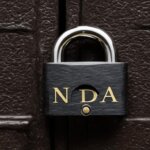Table of Contents
A non-disclosure agreement (NDA), also known as a confidentiality agreement, is a legally binding contract that establishes a confidential relationship between two or more parties. The purpose of an NDA is to protect sensitive information from being shared or disclosed to unauthorized parties. Non-disclosure agreements are commonly used in business negotiations, employee contracts, and when sharing confidential information with potential investors or partners.
There are two primary types of NDAs: mutual and non-mutual. NDAs are essential for protecting trade secrets, client information, marketing strategies, and other valuable or sensitive information.
In this article, we will explore the key takeaways of non-disclosure agreements, the benefits, enforceability, and limitations of NDAs, and provide practical insights to help you understand the importance of NDAs in various contexts.
Key Takeaways of Non-Disclosure Agreements
When it comes to non-disclosure agreements (NDAs), there are several key takeaways that individuals and businesses should be aware of. By understanding these essential points, you can navigate the intricacies of NDAs and ensure the protection of sensitive information.
Acknowledging a Confidential Relationship: The cornerstone of an NDA is acknowledging the existence of a confidential relationship between the parties involved. This acknowledgment serves as a legal contract and establishes the understanding that shared information must be kept confidential.
- Protecting Shared Information: One of the primary purposes of an NDA is to protect shared information from unauthorized disclosure. NDAs are commonly used in various scenarios, such as business negotiations and employee contracts, to safeguard trade secrets, proprietary information, and other valuable or sensitive data.
- Types of NDAs: There are two primary types of NDAs: mutual and non-mutual. Mutual NDAs are used when both parties involved are sharing sensitive information. On the other hand, non-mutual NDAs are employed when only one party is receiving confidential information.
Properly drafted NDAs should include specific elements to ensure their effectiveness. These elements may include participant identification, a clear definition of confidential information, exclusions of confidentiality, guidelines for appropriate use of the information, a defined time frame for confidentiality, and miscellaneous provisions that address potential contingencies.
Quote: “NDAs play a critical role in protecting valuable information and fostering trust between parties. It is imperative to tailor and include essential elements in an NDA to ensure its enforceability and effectiveness.” – Legal Expert
| Key Takeaways | Explanation |
|---|---|
| Acknowledge a Confidential Relationship | Establishes the understanding that shared information is confidential and must be kept private. |
| Protect Shared Information | Safeguards sensitive information from unauthorized disclosure, preserving trade secrets and proprietary data. |
| Types of NDAs | Mutual NDAs when both parties share sensitive information, and non-mutual NDAs when only one party becomes privy to confidential information. |
Benefits, Enforceability, and Limitations of NDAs
Non-disclosure agreements (NDAs) offer numerous benefits for employers. Firstly, they play a crucial role in establishing clear expectations for employees regarding the protection of sensitive information. By explicitly defining what constitutes confidential information, NDAs ensure that employees understand the importance of safeguarding trade secrets, client data, and proprietary strategies.
In addition to setting expectations, NDAs provide legal recourse in the event of a breach. If an employee violates the terms of an NDA, the employer can pursue breach of contract claims, breach of fiduciary duty claims, and other legal actions. This not only deters potential breaches but also serves as a means of recourse for companies seeking to protect their valuable intellectual property.
It is worth noting that NDAs are generally enforceable if they are drafted properly, supported by consideration (e.g., monetary compensation or employment opportunities), and not overly broad. However, there are limitations that can render an NDA unenforceable. For instance, if the language used is too vague or broad, it may be difficult to demonstrate the breach or establish the scope of the confidential information.
Furthermore, an NDA may be unenforceable if the information it seeks to protect is already widely known or not truly confidential. Similarly, courts may deem an NDA unenforceable if it contains provisions requesting illegal activities or goes against public policy. Therefore, it is essential to draft NDAs with precise language and considerations for potential limitations and enforceability challenges.
FAQ
What is a non-disclosure agreement (NDA)?
A non-disclosure agreement, also known as a confidentiality agreement, is a legally binding contract that establishes a confidential relationship between two or more parties. Its purpose is to protect sensitive information from being shared or disclosed to unauthorized parties.
Why are NDAs important?
NDAs are essential for protecting trade secrets, client information, marketing strategies, and other valuable or sensitive information. They are commonly used in business negotiations, employee contracts, and when sharing confidential information with potential investors or partners.
What are the primary types of NDAs?
There are two primary types of NDAs: mutual and non-mutual. Mutual NDAs are used when two parties are sharing sensitive information, while non-mutual NDAs are used when only one party is receiving confidential information.
What should be included in an NDA?
NDAs should include specific elements such as participant identification, definition of confidential information, exclusions of confidentiality, appropriate uses of information, time frame, and other miscellaneous provisions.
How do NDAs benefit employers?
NDAs establish employee expectations, protect trade secrets during information sharing, and provide additional legal recourse in case of a breach.
Are NDAs enforceable?
NDAs are generally enforceable if they are properly drafted, supported by consideration, and not overly broad. However, there are circumstances that may make NDAs unenforceable, such as language that is too broad, information that is not confidential or already widely known, or requests for illegal activities.
What are the consequences of violating an NDA?
Violating an NDA can result in breach of contract claims, breach of fiduciary duty claims, misappropriation of trade secrets, copyright infringement, and other intellectual property law violations.













